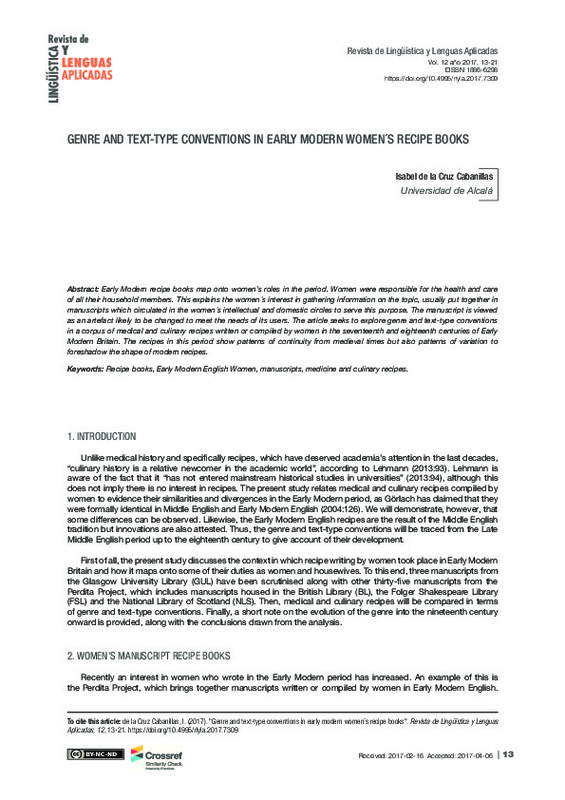Alonso Almeida, F. (2008). "The Middle English Medical Charm: Register, Genre and Text Type Variables", Neuphilologische Mitteilungen, 100: 27-42.
Alonso Almeida, F. (2013). "Genre Conventions in English Recipes, 1600-1800", Reading and Writing Recipe Books 1550-1800. Di Meo, M. and Pennell, S. (Eds.) Manchester: Manchester University Press, 68-92.
Carroll, R. (2003). Recipes for laces. Pragmatics & Beyond New Series, 137-165. doi:10.1075/pbns.119.07car
[+]
Alonso Almeida, F. (2008). "The Middle English Medical Charm: Register, Genre and Text Type Variables", Neuphilologische Mitteilungen, 100: 27-42.
Alonso Almeida, F. (2013). "Genre Conventions in English Recipes, 1600-1800", Reading and Writing Recipe Books 1550-1800. Di Meo, M. and Pennell, S. (Eds.) Manchester: Manchester University Press, 68-92.
Carroll, R. (2003). Recipes for laces. Pragmatics & Beyond New Series, 137-165. doi:10.1075/pbns.119.07car
Carroll, R. (2009). Vague language in the medieval recipes of theForme of Cury. Pragmatics & Beyond New Series, 55-82. doi:10.1075/pbns.189.07car
Carroll, R. (2010). "The visual language of the recipe: A brief historical survey", Food and Language Proceedings of the Oxford Symposium on Food and Cookery 2009. Hosking, R. (Ed.) Totnes: Prospect Books, 62-72.
Field, C. (2007). "Many hands hands: Wrting the Self in Early Modern Women's Recipes Books", Genre and Women's Life Writing in Early Modern England. Dowd, M.M. and Eckerle, J. A. Aldershot: Ashgate, 49-63.
Görlach, M. (s. f.). Text-types and language history: the cookery recipe. History of Englishes. doi:10.1515/9783110877007.736
Görlach, M. (2004). Text Types and the History of English. doi:10.1515/9783110197167
Hieatt, C. and Butler, S. (1985). Curye on Inglysch: English culinary manuscripts of the fourteenth century (including the Forme of cury). Oxford: OUP.
Hoey, M. (1986). "The discourse colony: a preliminary study of a neglected discourse type", Talking about Text: Studies Presented to David Brazil on his Retiremeny. Coulthard, M. Birmingham: English Language Research, University of Birmingham, 1-26.
Hoey, M. (2001). Textual Interaction. An introduction to written discourse analyses. London: Routledge.
Hunter, L. (2002). Books for daily life: household, husbandry, behaviour. The Cambridge History of the Book in Britain, 514-532. doi:10.1017/chol9780521661829.026
Jones, P. M. (s. f.). Medical literacies and medical culture in early modern England. Medical Writing in Early Modern English, 30-43. doi:10.1017/cbo9780511921193.004
Jucker, H. A. and Taavitsainen, I. (2013). English Historical Pragmatics. Edinburgh: Edinburgh University Press.
Lehmann, G. (2013). "Reading recipe books and culinary history: opening a new field", Reading and Writing Recipe Books 1550-1800. Di Meo, M. and Pennell, S. (Eds.) Manchester: Manchester University Press, 93-113.
Leong, E., & Pennell, S. (2007). Recipe Collections and the Currency of Medical Knowledge in the Early Modern ‘Medical Marketplace’. Medicine and the Market in England and its Colonies, c. 1450–c. 1850, 133-152. doi:10.1057/9780230591462_7
Mäkinen, M. (s. f.). Efficacy phrases in Early Modern English medical recipes. Medical Writing in Early Modern English, 158-179. doi:10.1017/cbo9780511921193.010
Taavitsainen, I. (2001). Middle English recipes: Genre characteristics, text type features and underlying traditions of writing. Journal of Historical Pragmatics, 2(1), 85-113. doi:10.1075/jhp.2.1.05taa
Taavitsainen, I. (2001). Changing Conventions of Writing: The Dynamics of Genres, Text Types, and Text Traditions. European Journal of English Studies, 5(2), 139-150. doi:10.1076/ejes.5.2.139.7309
Tebeaux, E. (1997). "Women and Technical Writing, 1475-1700: Technology, Literacy, and Development of a Genre", Women, Science and Medicine 1500-1700. Hunter, L. and Hutton, S. (Eds.) Phoenix Mill Trupp, Gloucestershire: Sutton, 29-62.
[-]








